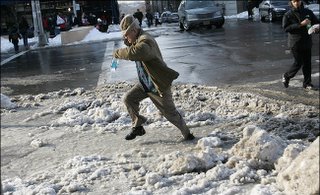I found this article from the NY Times rather humerous.
Having endured the big snow, 26.9 inches in 24 hours, New York endured something yesterday that created fresh headaches: the big melt.
That was why pedestrians crossing the street had to do the long jump at the corner. On a day when the temperature climbed as much as nine degrees above freezing, puddles loomed like lakes.
It was why blocks of snow the size of Ping-Pong tables broke free and sailed off rooftops, creating instant snow flurries, unless they landed on someone, creating an instant snowman.
It was why street-level streams beneath elevated subways in Queens were fed by a daylong drizzle from the tracks and platforms.
It was why cars seemed to spray a slushy, mucky mess wherever they went, and why people who just wanted to have one last snowball fight — and wanted to have it on the street — were splashed and splattered by buses whose drivers just wanted to keep to their schedules.
"It's disgusting," said Renee Young, a publicist in Manhattan. "Water is pouring off the buildings, so if you walk too close to the buildings, you get drenched."
And then there was what was underfoot, an unpredictable and potentially slippery coating on the pavement.
"You have to concentrate," said Evelyn Gatzonis, who owns a spa in Astoria, Queens, and walked to work in leather boots with 41/2-inch stiletto heels. (It was Valentine's Day, after all, she said.)
There was a lot to concentrate on: avoiding potholes in the making, and avoiding the sludgy, brackish liquid that had already filled them.
"It's like a strawberry daiquiri that's been out for five minutes and the stuff has started to separate so the syrup's on the bottom and ice is on the top," said Adele Morrissette, an investment banker whose office is in Rockefeller Center. "In this case, the syrup ... you don't want to know. The streets weren't clean before it snowed."
There will probably be more syrup today, as the forecast calls for the temperature in Manhattan to rise to 52 degrees, and more grumbling. Gladis Wallace of the Bronx said she loved a good snowstorm, "but the aftermath is a bit much."
"You've got big puddles of ice-cold melted snow," Ms. Wallace said. "You've got to jump over them. I've been trying to find a way around them without having to step into a puddle that's past your ankle."
Charles G. Sturcken, a spokesman for the city's Department of Environmental Protection, posited that when melted, a foot of snow equals an inch of rain. "So this is really like three inches of rain," he said. "The sewers should be able to handle this. Had we gotten rain at 51 degrees, between the melt and the rain, you'd fill up the system and go overboard. But this looks like an easy melt."
Not on the street, where the big melt changed the routines of those trying to get around.
"On Day 1, it was a mountain-climbing thing," said Lisa Kovitz, who commutes to Manhattan from Ossining, N.Y. "You have to step in the footprints of the other person.
"By Day 2, someone has taken some sort of sharp object and cut the Khyber Pass in the mountain," she continued, "but at the other end of the Khyber Pass is the lake."
Ms. Morrissette, the investment banker, encountered a lake on the way to work, in ankle-high hiking boots, and water seeped in through the eyelets. For the rest of the day, she alternated between the sunny side of the street, with puddles, and the shady side, where the walkways were narrower because there was more snow.
Judith Altreuter, the production director of the Modern Language Association in Manhattan, had the reason behind the lake problem figured out. "Why don't they shovel the drains?" she asked. "It's so obvious that's the reason. The people who shovel, how hard would it be for them to learn where the drains were? In 25 years of living in New York, I've seen no advance on this learning curve."
But Keith Mellis, a spokesman for the Sanitation Department, said workers were paying attention to the drains, which his agency calls catch basins.
"They need to be clear," he said. "We're out there clearing them. We're getting the bulk of the snow out of the way, but when Mother Nature helps us even more with warmer weather, we want to make sure the catch basins are able to receive the receding water."
People who did not excavate their cars on Monday faced a double headache yesterday: snow and water. Larry Flowers, who repairs and installs windows, discovered that to clear off his Ford Expedition he had to stand in a river of sludgy melted snow.
"It's sloppy," he said of East 162nd Street in the Bronx, near Teller Avenue, where his sport utility vehicle was parked. The city, which suspended alternate-side parking regulations yesterday and today, said the rules would be reinstated tomorrow. But parking meters will be in operation today.






